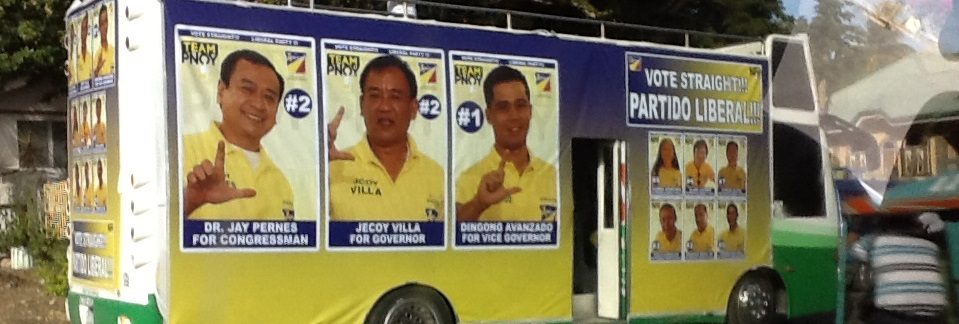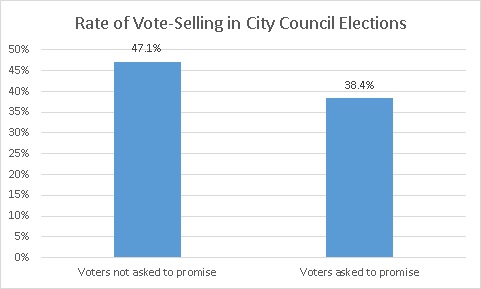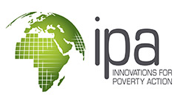
I Promise Not to Sell My Vote
Organization : Innovations for Poverty Action
Project Overview
Project Summary
Voters in the Philippines were asked to promise not to take any money from candidates or their representatives before local elections.
Impact
In a small-scale election, the promise reduced vote-selling by 10.9 percentage points (from 47.1 percent in the group who did not make promises to 38.4 percent in the group of voters who made promises).
Cost
The cost of this program was $8.00 per voter reached.
Source
Source
Challenge
Vote-buying and vote-selling generate immediate benefits for the individuals engaging in them, but obstruct the democratic process and erode trust between constituents and political institutions. A common approach to curb this practice is to try to convince voters not to sell their votes.
Design
Prior to municipal elections for mayor, vice-mayor, and city council in Sorsogon City, Philippines, researchers showed voters a video clip on a hand-held electronic device.
The clip was part of a voter education campaign that used humor to encourage viewers to turn out to vote, vote for honest and competent candidates, and avoid vote-selling. It featured Mae Paner, a political activist and actress, as the fictional character “Juana Change.”

Screen requesting voters make a promise not to sell their votes.
After the video, voters were shown a screen asking them to make a promise: “Would you promise not to take the money from any candidate or local leader before the elections?” Participants were asked to tap one of two images. Tapping the left image (of a handshake, above the words “Yes, I promise.”) would signify agreement to promise, and tapping the right image (of an open hand in a “halt” signal, above the words “No, I can’t make that promise.”) would indicate refusal to promise. Participants who agreed to make the promise by tapping on the image of the handshake were then asked, on the next screen, to write the words “I promise” in a blank space using their finger.
Impact

A randomized evaluation found that voters who were given the chance to promise were 10.9 percentage points less likely to sell their vote in the city council race. Forty-seven percent of voters in the group who did not have the opportunity to make the promise reported switching their vote before the election, whereas only 38.4 percent of voters who were given the chance to promise not to sell their vote switched their vote.
What worked best?
- Eliciting promises not to take any money before the elections, rather than to vote one’s conscience regardless of having taken a bribe. Researchers also randomly assigned a group of voters to be offered the chance to promise to vote their conscience even if they took money from a candidate before an election. These promises were not effective, and in fact appeared to increase vote-selling for some voters.
- Lower-stakes, local elections, in which the vote-buying payments were relatively small. In the higher-stakes mayoral and vice-mayoral elections, neither promise had any effect on vote-selling.
Implementation Guidelines
Inspired to implement this design in your own work? Here are some things to think about before you get started:
- Are the behavioral drivers to the problem you are trying to solve similar to the ones described in the challenge section of this project?
- Is it feasible to adapt the design to address your problem?
- Could there be structural barriers at play that might keep the design from having the desired effect?
- Finally, we encourage you to make sure you monitor, test and take steps to iterate on designs often when either adapting them to a new context or scaling up to make sure they’re effective.
Additionally, consider the following insights from the design’s researcher:
Would this work elsewhere?
This approach has only been tested in the Philippines in municipal elections. In this context, the research indicates that simply eliciting a promise not to sell votes can reduce vote-selling. Researchers believe that this result may be generalizable to other contexts where the same basic conditions apply:
- Where the elections are low stakes, and the vote-buying payments are therefore also relatively low;[1]
- Where vote-buying and selling (although illegal) is common;
- Where party loyalty is not the dominant dynamic in local elections, and candidates develop personalized networks of support;
- Where the fear/threat of coercion or violence is low.
As with every intervention, effective implementation would also be required for this approach to work elsewhere, and all interventions benefit from rigorous monitoring and evaluation.
Advice for Implementers
- Asking participants to write “I promise” is but one way to formalize making the promise, and others may be more appropriate in your context. For example, a religious group in the Philippines asked members to light a candle as they made a promise. The importance of formalizing the commitment has not been rigorously evaluated, but may increase the psychic cost of breaking the promise.
- If including a voter education component, researchers recommend something humorous or entertaining, that retains voters’ attention and delivers the message in a short amount of time.
- If using tablets or smartphones, remember to keep devices fully charged and make provisions for recharging devices in the field.
Additional Tools and Resources for Implementers
Recruitment script in English:
Hello, my name is_____. I am working with Innovations for Poverty Action along with the University of Michigan. We are researching voter education campaigns that can promote civic competence. We are asking you to participate because you are a resident of and a bona fide registered voter in Sorsogon City.
If you agree to be part of the research study, you will be asked to participate in a survey. We will ask questions about your voting behavior in the past and voting intentions for the upcoming May elections. We will also ask you to watch a 3-minute video clip relating to the elections.
While you may not receive a direct benefit from participating in this research, we hope that this study will contribute to improving the efficacy of voter education campaigns and promoting greater civic competence among Filipino.
Are you available to participate in our study?
(If asked) This interview will take approximately 30 minutes. If you do not have time to do the interview right now, we can arrange to come back at a later time.
Recruitment Script in Bicol:
Dios marhay na adlaw, ako tabi si . Nagtatrabaho ako sa Innovations for Poverty Action kasabay san University of Michigan. Igwa tabi kami sin research tungkol sa voter education campaigns o mga kampanya para sa edukasyon kan mga botante. Ini- imbitaran ka tabi namon magpartisipar sa research na ini, bilang registradong botante nan residente kan Sorsogon City.
Inhahagad tabi namon an partisipasyon nindo sa paagi san pagsimbag nindo sa saro na sarbey. An mga hapot sa sarbey tungkol sa mga hinimo mo kaugnay sa mga nakaaging eleksyon asin mga intensyon mo sa pag-boto niyan na maabot na eleksyon. Igwa man po kami sin halip-ot na video na ipapakita saimo na may kaugnayan sa eleksyon.
Maski ngani wara kami maipo-promisa sa imo na anuman na direktang benepisyo sa pag- participar sa pagaadal na ini, inlalayon namon na makabulig an pag-aadal na ini para ma- pagayon asin mapamarhay pa an mga kampanya para sa edukasyon kan botanteng Pilipino.
May panahon ka tabi na mag-partisipar sa pag-aadal na ini?
(If asked) An interview na ini malawig sin mga 30 minutos. Kun wara ka tabi panahon sa interview na ini sa niyan, pwede man tabi kita mag-iskedyul sin iba na oras kun sano may panahon ka na.
Cost effectiveness
Eliciting a simple promise not to sell one’s vote can be a remarkably low-cost intervention. Although the original study relied on promises recorded on a handheld electronic device, the use of these devices may not be essential (voters could be asked to record their promise using pen and paper, although this variation has so far not been rigorously evaluated).
The cost per person of the original intervention was roughly $8.00/person using the following assumptions:
- Personnel: $3113.84 (20 field officers, each can visit 5 voters in a day)
- Tablets: $3255.81 (20 refurbished tablets)
- Transportation allowance: $269
- Cellphone/communication allowance: $25.50
- Software/App: $89
Other costs you are likely to encounter include:
- If including a voter education component as in the original study, you will need to add the cost of producing and distributing voter education materials
For more guidance on implementing this design, click “I want to try this” from the left drop-down menu.
Project Credits
Researchers:
Allen Hicken Contact University of Michigan
Stephen Leider Stephen M. Ross School of Business, University of Michigan
Nico Ravanilla Stanford University
Dean Yang Gerald R. Ford School of Public Policy, University of Michigan; Bureau for Research and Economic Analysis of Development; National Bureau of Economic Research


